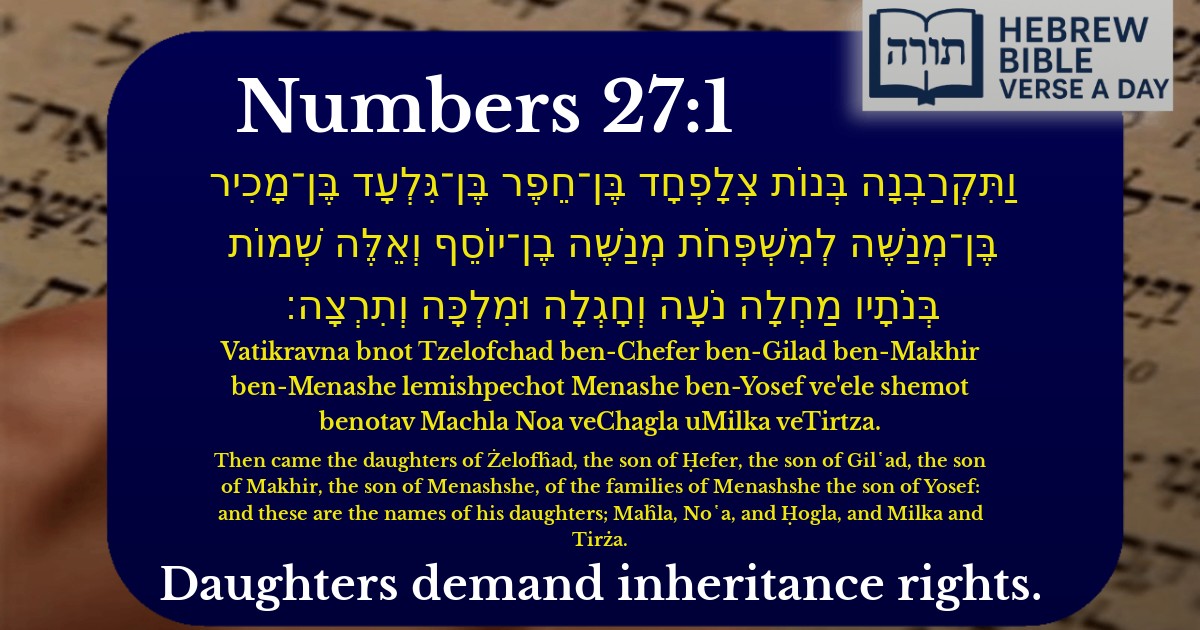Join Our Newsletter To Be Informed When New Videos Are Posted
Join the thousands of fellow Studends who rely on our videos to learn how to read the bible in Hebrew for free!
Hebrew Text
וַתִּקְרַבְנָה בְּנוֹת צְלָפְחָד בֶּן־חֵפֶר בֶּן־גִּלְעָד בֶּן־מָכִיר בֶּן־מְנַשֶּׁה לְמִשְׁפְּחֹת מְנַשֶּׁה בֶן־יוֹסֵף וְאֵלֶּה שְׁמוֹת בְּנֹתָיו מַחְלָה נֹעָה וְחָגְלָה וּמִלְכָּה וְתִרְצָה׃
English Translation
Then came the daughters of Żelofĥad, the son of Ḥefer, the son of Gil῾ad, the son of Makhir, the son of Menashshe, of the families of Menashshe the son of Yosef: and these are the names of his daughters; Maĥla, No῾a, and Ḥogla, and Milka and Tirża.
Transliteration
Vatikravna bnot Tzelofchad ben-Chefer ben-Gilad ben-Makhir ben-Menashe lemishpechot Menashe ben-Yosef ve'ele shemot benotav Machla Noa veChagla uMilka veTirtza.
Hebrew Leining Text
וַתִּקְרַ֜בְנָה בְּנ֣וֹת צְלׇפְחָ֗ד בֶּן־חֵ֤פֶר בֶּן־גִּלְעָד֙ בֶּן־מָכִ֣יר בֶּן־מְנַשֶּׁ֔ה לְמִשְׁפְּחֹ֖ת מְנַשֶּׁ֣ה בֶן־יוֹסֵ֑ף וְאֵ֙לֶּה֙ שְׁמ֣וֹת בְּנֹתָ֔יו מַחְלָ֣ה נֹעָ֔ה וְחׇגְלָ֥ה וּמִלְכָּ֖ה וְתִרְצָֽה׃
Parasha Commentary
📚 Talmud Citations
This verse is quoted in the Talmud.
📖 Bava Batra 119b
The daughters of Zelophehad are discussed in the context of inheritance laws, particularly their claim to inherit their father's portion in the land of Israel.
📖 Sotah 30a
The daughters of Zelophehad are mentioned in relation to their wisdom and righteousness in approaching Moses to request their inheritance.


The Daughters of Tzelofchad and Their Lineage
The verse introduces the daughters of Tzelofchad, who approached Moshe with a legal question regarding inheritance in the Land of Israel. Their lineage is traced back to Menashe, the son of Yosef, emphasizing their connection to the tribe of Menashe. Rashi (Bamidbar 27:1) notes that the Torah specifically mentions their descent from Yosef because Yosef had a deep love for the Land of Israel, as seen when he requested his bones be brought there (Bereishit 50:25). This connection highlights the righteousness of the daughters, who similarly cherished the Land and sought to ensure their family's portion in it.
The Significance of Their Names
The names of the five daughters—Machlah, Noa, Choglah, Milkah, and Tirtzah—are listed with care. The Midrash (Bamidbar Rabbah 21:11) explains that each name reflects their righteous character and their devotion to Hashem:
Their Legal Argument and Its Impact
The daughters of Tzelofchad presented their case before Moshe, arguing that they should inherit their father’s portion since he had no sons (Bamidbar 27:4). The Talmud (Bava Basra 119b) praises their wisdom, noting that they framed their request at the appropriate time—when Moshe was teaching the laws of inheritance. Rambam (Hilchos Nachalos 6:1) derives from this episode that women inherit when there are no male heirs, establishing a key halachic principle. Their righteousness is further emphasized in the Midrash (Tanchuma Pinchas 9), which states that they were learned in Torah and merited having their names recorded in Scripture.
Their Legacy in Jewish Law
The ruling in favor of the daughters of Tzelofchad became a foundational precedent in Jewish inheritance law. The Sifri (Bamidbar 133) teaches that their case demonstrated the importance of seeking clarity in halacha and advocating for justice. Their story also underscores the value of women’s participation in Torah scholarship and legal discourse, as they were praised for their understanding and sincerity.